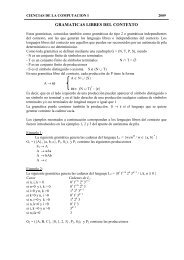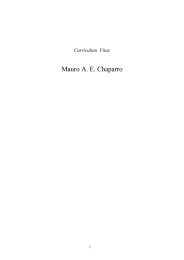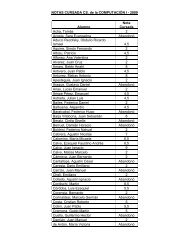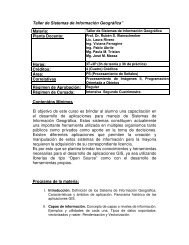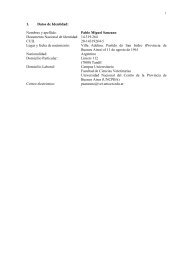Libro de Resúmenes / Book of Abstracts (Español/English)
Libro de Resúmenes / Book of Abstracts (Español/English)
Libro de Resúmenes / Book of Abstracts (Español/English)
Create successful ePaper yourself
Turn your PDF publications into a flip-book with our unique Google optimized e-Paper software.
Resumenes 39<br />
Figure 1: Plano <strong>de</strong> fase<br />
A predator-prey mo<strong>de</strong>l to the citrus sud<strong>de</strong>n <strong>de</strong>ath<br />
Citrus Sud<strong>de</strong>n Death (CSD) is a disease that has affected sweet<br />
orange trees grafted on Rangpur lime. Researches have shown that the<br />
ducts which lead nutrients generated by the photosynthesis to the roots,<br />
become clogged and <strong>de</strong>generated. Without foods, the roots putrefy, the tree<br />
<strong>de</strong>cays and die.<br />
Preliminary studies have suggested that a virus transmitted by<br />
insects known as aphids causes this disease. Among the most known<br />
predators in citrus belonging to the Coleoptera Or<strong>de</strong>r and the Coccinelidae<br />
Family, the Cycloneda Sanguinea (ladybug) is an important agent for<br />
biological control because it eats aphids. Research data indicate that each<br />
larva <strong>of</strong> these predators can consume up to 200 aphids a day and the adults<br />
prey, in average, 20 aphids a day. This means that the <strong>de</strong>gree <strong>of</strong> predation<br />
<strong>of</strong> adults is, in average, 10% <strong>of</strong> the <strong>de</strong>gree larvae’s <strong>of</strong> predation and that,<br />
therefore, a mathematical mo<strong>de</strong>l to represent the interaction between<br />
aphids and ladybugs should take into account such difference in the class <strong>of</strong><br />
predators.<br />
In this work, we establish a mo<strong>de</strong>l <strong>of</strong> type predator-prey, based on<br />
fuzzy rules, to represent the interaction between the aphids (prey) and<br />
(ladybugs (predators) in the citriculture, replacing the standard mo<strong>de</strong>ls,<br />
from the differential equation system.<br />
The variables (inputs) are the rate <strong>of</strong> quantity <strong>of</strong> preys (x) and the<br />
rate <strong>of</strong> potential <strong>of</strong> predation ( P y ), given by Py = p1<br />
+ 0. 1*<br />
p2<br />
, where p 1 is the<br />
quantity <strong>of</strong> larvae <strong>of</strong> this population and p 2 is the population <strong>of</strong> adults. The<br />
outputs are the variation <strong>of</strong> prey, (x’), and the variation <strong>of</strong> the potential <strong>of</strong><br />
predation, ( P y'<br />
). The rules <strong>of</strong> the rule-based fuzzy system can be<br />
exemplified as follows: "If the quantity <strong>of</strong> preys is high and the potential <strong>of</strong><br />
predation is very low, then the variation <strong>of</strong> preys has a little increase and<br />
the variation <strong>of</strong> the potential <strong>of</strong> predation increases a lot."<br />
From the Mamdani Inference Method and the <strong>de</strong>fuzzification <strong>of</strong> the<br />
Center-<strong>of</strong>-Gravity, we have obtained the rates <strong>of</strong> variation <strong>of</strong> preys (x’) and<br />
potential <strong>of</strong> predation, ( P y'<br />
). Using a process <strong>of</strong> numerical integration, the<br />
Trapezoidal Rule, for example, we finally get the population <strong>of</strong> preys<br />
(aphids) and potential <strong>of</strong> predation <strong>of</strong> the predators (ladybugs), whose<br />
phase-plane is illustrates in Figure 1.



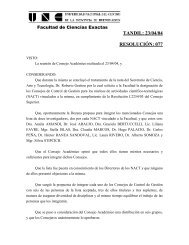
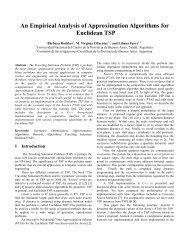
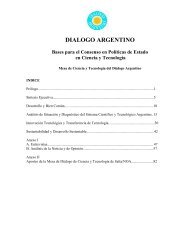
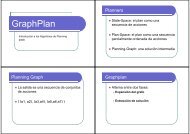
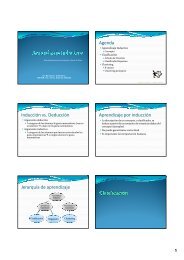
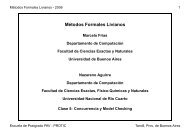
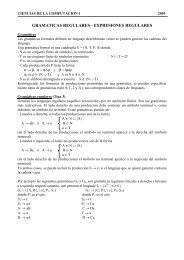

![Clase 13 [pdf]](https://img.yumpu.com/19616969/1/190x245/clase-13-pdf.jpg?quality=85)

